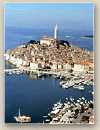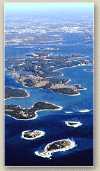|
site
map |
|
|
|
The area that stretches in a narrow belt along the northern coast, from Preluk Cove, near Volosko, to the mouth of the Zrmanja River, is known as Hrvatsko Primorje (the Croatian Seaside). Some people call it Kvarner. To the north and east it is sheltered by mountains: the heavily wooded UËka, Risnjak and Velika Kapela in the north, with Velebit running parallel to the coastline. On the other side are the warm waters of the Adriatic. Croatian Primorje also includes all the Bay of Kvarner islands, such as Krk, Cres, Lošinj, Rab and Pag. The coastal belt is narrow and rocky, with small coves. This area, with its natural diversity, is an appealing destination for mountaineers, hunters and lovers of nature, alike. Sunbathers will also find their place in the sun on the beaches of Crikvenica and Novi Vinodolski, as well as on the picturesque islands. THE OPATIJA RIVIERA Opatija Opatija is located 14 kilometers west of Rijeka. Named after the Benedictin Abbey (opatija=abbey) mentioned in 1453, Opatija is famous as “the first Lady of Croatian tourism” and “the pearl of the Adriatic”. Thanks to its gentle climate, Opatija is also famous for rich vegetation and parks. The first representative villa - Villa Angiolina, was built in 1844. The owner of the aforementioned villa opened a botanical garden with exotic species from around the world, which sailors collected for him over the course of their travels. When the railroad from Vienna to Trieste and Rijeka was built, Opatija and its riviera became a very popular winter resort for the Austro-Hungarian aristocracy, who built villas all along the coast. The Southern Railway Association built the first grand hotel on the eastern Adriatic, the Hotel Kvarner. Opatija is also renown for its health spas, specifically in the treatment of cardiovascular illnesses and rheumatism. Hotels: Ambasador (L); Grand Hotel Adriatic (A); Admiral (A); Kvarner-Amalia (A); W.A. Mozart (A); Agava (B); Belvedere-Rosalia (B); Brijuni (B); Dubrovnik (B); Imperial-Atlantik (B); Istra (B); Jadran (B); Kristal (B); Opatija (B); Palace-Bellevue (B); Palme (B); Paris (B); Residenz (B); Zagreb (B); Astoria (B); Continental (B); Dubrava (B); Galeb (B); Royal (B); Villa Ariston; Villa Vranje; Villa Madona Marina: Marina Admiral - situated in the hotel harbor, it has 160 floating docks, 40 dry docks, a 5 ton crane and is open all year. Mošćenička Draga A former fishing village, Mošćenićka Draga is now one of the most famous tourist destinations in Kvarner Bay. It is on the eastern coast of Istria, on the road from Rijeka to Pula. Lovran This small town on the Liburnian coast of eastern Istria, 6 km. from Opatija on the road from Rijeka to Pula, is one of the most attractive resorts on the Opatija Riviera. There is a 12 kilometer walking path along the sea from Lovran to Opatija and further to Volosko. Lovran is mentioned under the name Lauriana as early as the 7th century. On the main square are a Romanesque belfry and a number of baroque houses. The parish church of St. Juraj from the 14th century holds the most complete collection of Gothic wall paintings, the work of an anonymous master (before 1479). Ičiči This small harbor is at the foot of Učka Mountain, between Opatija and Lovran. It used to be a port, but is now only a summer resort. It is the starting point for mountaineering expeditions on Veprinac and in the peaks of Učka.
THE CRIKVENICA AND NOVI
VINODOLSKI RIVIERA Crikvenica This picturesque small town is located 37 kilometers south of Rijeka. Crikvenica was converted from a fishing village into a tourist center at the end of the 19th century. The first beach facilities were in place in 1888; the first hotel, the Clotilda, was built in 1891. Also in 1891, the first tourist guide on Crikvenica was published in Graz, Austria, in the German language. The settlement developed at the end of the 14th century, built around an old church, “crikva,” which provided the name for the town. A Paulist monastery was built in 1412. For years, Crikvenica was an important educational center. This is where the famous painter of miniatures, Julije Klović, was educated. Later, the monastery became a military hospital. Today, it is a hotel. The church of the Blessed Virgin Mary was built in Gothic style, modeled after the original “crikva.” The historical core of the town was remodeled in baroque style. Hotels:Palace-Therapia (A); Crikvenica (B); Esplanade (B); International (B); Ka?tel (B); Mediteran (B); Zagreb (B); Park (B); Omorika (B); “Omorika” Annexes and Pavillions (B); Ad Turres (B); “Ad Turres” Pavillions; Thalassotherapia. Novi Vinodolski This small town is located 45 kilometers south of Rijeka. The diverse vegetation, clear sea and pristine beaches established it as a famous tourist resort. Inhabited as early as Roman times, Novi Vinodolski later became a fortress of the Frankopan Princes. The famous Vinodol Law of 1288, an important medieval customs law, was written here in Glagolitic script. It is now kept at the National University Library in Zagreb. The Frankopan citadel, the 13th century fortress in which the Vinodolski Law was signed, has been preserved. Today it houses a museum of documents, ornaments and ethnography. Hotels: Lišanj (B); “Horizont” Annex (B); “Zagori” Tourist Resort (B) Camps: Zagori (II) Jadranovo This town is located nine kilometers north of Crikvenica. It is a popular destination because of its fresh water springs, pine forest and numerous beaches. Dramalj This former fishing village is almost a part of Crikvenica today. The two are connected by a walking path and long, beautiful beaches, lined by modern hotels and villas. The old olive mill is a historical monument. Hotels: Riviera (B) Selce This is a typical, small coastal town. It lies in a picturesque cove and is connected to Crikvenica by a walking path. Selce was built on the location of a former Roman settlement, Ad Turres, from which many historical artifacts have been discovered. The town grew rapidly in the 19th century. In 1894, a tourist company was founded in Selce which soon built a public swimming pool, beach and 10 cabins. The first postcards were printed in 1903. In 1911, the first hotel, the “Rokan,” was built. The old olive mill is considered a cultural monument. It currently houses a museum. Hotels: Varaždin (A); Slaven (B); Selce (B); Marin (B); “Jadranka” Tourist Resort Camps: Selce (II); Uvala Slana (II) For details and you questions please contact as here |
|
|
Real
Estate Nekretnine, Split,
Croatia tel:
+356 79010337 Terms and Conditions | Privacy statement | info@nekretnine.org |

